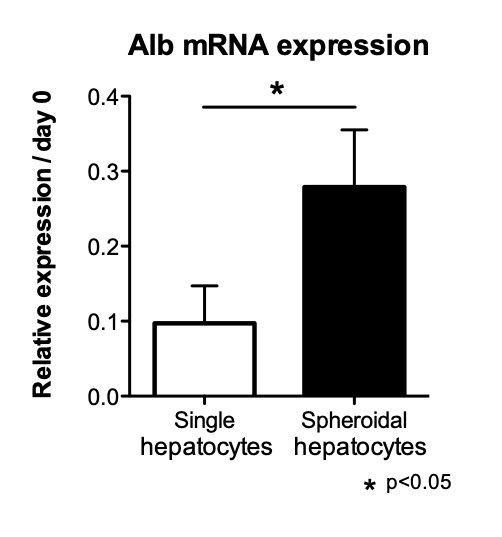The Efficacy of Spheroidal Hepatocytes for Hepatocyte Transplantation
K. Shibuya, M. Watanabe, Y. Ganchiku, R. Kanazawa, Y. Koshizuka, M. Zaitsu, R. Goto, A. Taketomi
Department of Gastroenterological Surgery Ⅰ Hokkaido University Graduate School, Sapporo, Japan
Meeting: 2019 American Transplant Congress
Abstract number: A124
Keywords: Bioengineering, Hepatocytes, Metabolic disease
Session Information
Session Name: Poster Session A: Islet Cell and Cell Transplantation
Session Type: Poster Session
Date: Saturday, June 1, 2019
Session Time: 5:30pm-7:30pm
 Presentation Time: 5:30pm-7:30pm
Presentation Time: 5:30pm-7:30pm
Location: Hall C & D
*Purpose: Hepatocyte transplantation (HCTx) is expected to expand its application as a next generation therapy alternative to liver transplantation. Following HCTx, the liver function improves in many cases but is temporary, and finally liver transplantation is needed. As a problem to be overcome, single hepatocyte (SH) is injured during the isolation process from the liver. In addition, the majority of SH transplanted into the liver is subsequently destroyed by the innate immune response, and a long-term engraftment cannot be achieved. Spheroidal hepatocyte (SP) can be developed by self-aggregation of SH. SP has a cellular environment close to the liver tissue, is structurally stronger, and maintains liver function. We evaluated our hypothesis that SP can be applied to hepatocyte transplantation.
*Methods: SHs were isolated from the C57BL/6 mouse liver, and SP was induced by hanging drop culture of SHs. The concentration of albumin (Alb), aspartate aminotransferase, lactate dehydrogenase, urea, total bile acid and apolipoprotein E (Apo E) in the supernatant, and intracellular Alb mRNA expression were evaluated and compared with SH cultured on collagen coat dish. SH or SP were transplanted into the liver of Apo E KO (-/-) mice via the portal vein, and the Apo E concentration in the blood was measured.
*Results: The Alb concentration in the SP culture medium (10.6 ± 1.3 μg/dL) and the relative expression level of Alb mRNA in the cells (0.279 ± 0.132 times, ratio immediately before seeding) were significantly higher than those of SH (7.9 ± 2.3 μg/dL, 0.097 ± 0.086 times) (p = 0.007,p = 0.049) (Fig.1, 2). Apo E was detected in the SP or SH culture medium respectively (1.97 ± 0.98 μg/mL, 2.16 ± 0.62 μg/mL). After the mouse HCTx, Apo E was detected in the blood of SP or SH transplanted mice at least until 6 weeks after transplantation.
*Conclusions: The albumin productivity of spheroidal hepatocyte was significantly better than those of single hepatocyte. Spheroidal hepatocyte produced Apolipoprotein E, and maintained its function even after transplantation. Spheroidal hepatocyte can be applied to hepatocyte transplantation.
To cite this abstract in AMA style:
Shibuya K, Watanabe M, Ganchiku Y, Kanazawa R, Koshizuka Y, Zaitsu M, Goto R, Taketomi A. The Efficacy of Spheroidal Hepatocytes for Hepatocyte Transplantation [abstract]. Am J Transplant. 2019; 19 (suppl 3). https://atcmeetingabstracts.com/abstract/the-efficacy-of-spheroidal-hepatocytes-for-hepatocyte-transplantation/. Accessed November 9, 2025.« Back to 2019 American Transplant Congress


